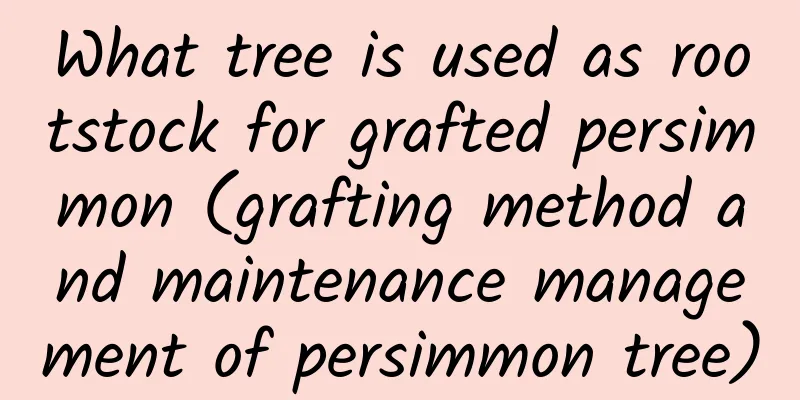What tree is used as rootstock for grafted persimmon (grafting method and maintenance management of persimmon tree)

1. What are the rootstocks for grafted persimmon trees?Grafting is the process of achieving optimized complementarity between plants of the same family and genus. To put it simply, it is the process of grafting high-yield and high-quality scions onto rootstocks that are adapted to the local soil and climate environment and have strong disease resistance and prevention capabilities, so that the two can grow in harmony with each other. The same is true for the grafting of persimmon trees. When grafting persimmon trees, it is advisable to choose wild persimmon trees with strong local adaptability and disease resistance and obsolete persimmon trees with poor quality and low yield but strong adaptability as rootstocks, such as: soft date tree, Luofu persimmon, hairy persimmon, black persimmon, old crow persimmon, sweet persimmon, etc. 2. How to graft persimmon trees to achieve a high survival rateThe grafting of persimmon trees is the same as that of other woody plants, usually using bud grafting and branch grafting. During grafting, since persimmon trees contain a lot of tannin, it is easy for the wound surface to oxidize and form a black isolation layer, which hinders the healing of the healing tissue and thus affects the survival rate. Therefore, the grafting time should be selected in early spring when the sap has not yet flowed. If the grafting time is late and the sap has begun to flow, the grafting action must be quick and accurate, and the bandage must be secure. At the same time, attention should be paid to the disinfection of cutting instruments and the affected surface beforehand to eliminate the hidden dangers at the source. 1. Bud graftingBud grafting is a grafting method that uses the plump buds on healthy fruiting branches as scions, embeds or sticks them into the cut of the rootstock, and then closely ties them together to allow them to heal and grow. When using bud grafting to graft persimmon seedlings, be sure to make the cut surface of the scion and the rootstock smooth and make the cambium fit tightly. At the same time, expose the buds and wrap them firmly with tape. 2. GraftingBranch grafting is a grafting method that uses healthy fruiting branches of selected varieties as scions to make them grow in harmony with the rootstock. This grafting method is most suitable for grafting slightly larger seedlings. When grafting persimmon seedlings, first cut a smooth bevel on the scion; then insert the scion between the bark and xylem of the rootstock, so that the affected surface of the scion fits as closely as possible to the wood layer of the rootstock; finally, wrap it to stabilize it. It is worth noting that whether it is bud grafting or branch grafting, it is best to graft it on the sunny side. At the same time, the tips and branches that consume nutrients on the rootstock should be cut off to concentrate the sap to flow to the affected area and promote survival. 3. How to care and manage grafted seedlingsAfter the scion and the rootstock are grafted, the subsequent maintenance and management is the key to promoting the survival of the grafted seedlings. The same is true for the grafting of persimmon seedlings. During the maintenance process, the following points should be noted. 1. Disinfection, sterilization and insect preventionIn early spring, the temperature starts to rise, and it is the season when various bacteria begin to breed and insect eggs begin to hatch. After the persimmon seedlings are grafted, because the persimmon seedlings are still weak and the wounds have not healed, special attention should be paid to the disinfection of the surrounding environment and the elimination of insect eggs. Therefore, after grafting, you can spray the affected area and the surrounding environment with diluted carbendazim solution and insect repellent solution to prevent bacteria from invading the affected area and pests from gnawing at the buds. 2. Ensure water humidityAfter the persimmon seedlings are grafted, if it has not rained for a long time and there is continuous dry and cold weather, it is advisable to water the rootstock in time to keep the soil moist and avoid waterlogging. At the same time, spray water mist around to keep the air moist and prevent the affected mouth from drying out. 3. Keep warmIn early spring, the temperature is still unstable, and it is easy to have a cold snap, and the persimmon seedlings and the affected area cannot withstand frost and snow. Therefore, if there is wind and snow, it is advisable to block the wind and cold and keep warm appropriately. The method depends on the area. 4. Avoid exposure to sunlight and heavy rainNewly grafted persimmon seedlings should be kept away from direct sunlight and heavy rain to avoid dry mouth and bacterial infection, which will affect the survival rate. Therefore, if there is direct sunlight or heavy rain, it is advisable to provide appropriate shade and rain protection for the grafted seedlings to allow the affected surface to heal smoothly. |
Recommend
Does ivy bloom?
Flowering period Ivy is an evergreen vine that ca...
When is the best time to prune greengage trees?
Pruning of greengage trees Pruning during the you...
What soil is suitable for planting Monstera
Soil for Monstera Monstera likes acidic soil. The...
Why do clover leafs close up?
1. Name This phenomenon is very normal. There is ...
What are the main varieties of octagonal gold plates?
The main varieties of golden plate Dwarf Aglaonem...
How to trim loofah
When to prune loofah The first pruning of loofah ...
What kind of soil is good for growing Clivia
1. Types Clivia likes warm and semi-shaded places...
There are several types of elm trees
1. Elm Ulmus pumila is a sub-arbor deciduous tree...
Can South African leaf seedlings be grown indoors?
Can South African leaf seedlings be grown indoors...
What to do if there are black spots on the leaves of green radish
1. Improve ventilation Reason: Poor air circulati...
Can I keep green radish at home? What are the precautions for growing green radish at home?
1. Can it be put You can put green ivy at home. I...
Common ornamental plants in northern winter
one. Red yew: The red yew is a shrub and a relati...
How much do you know about succulent pots?
1. We must first understand the growth habits of ...
How to keep seeds of fragrant lily? Seed planting time and method
How to keep seeds of perfume lily The scented lil...
How to grow dianthus on the balcony, what should be paid attention to
1. Light exposure When growing dianthus at home, ...









